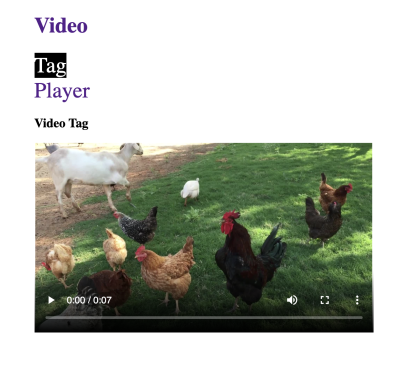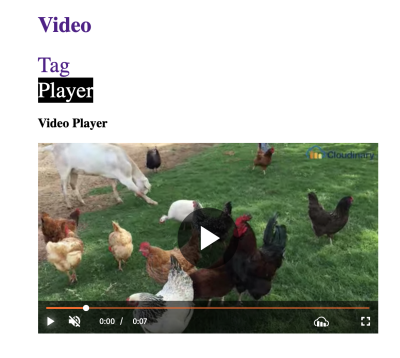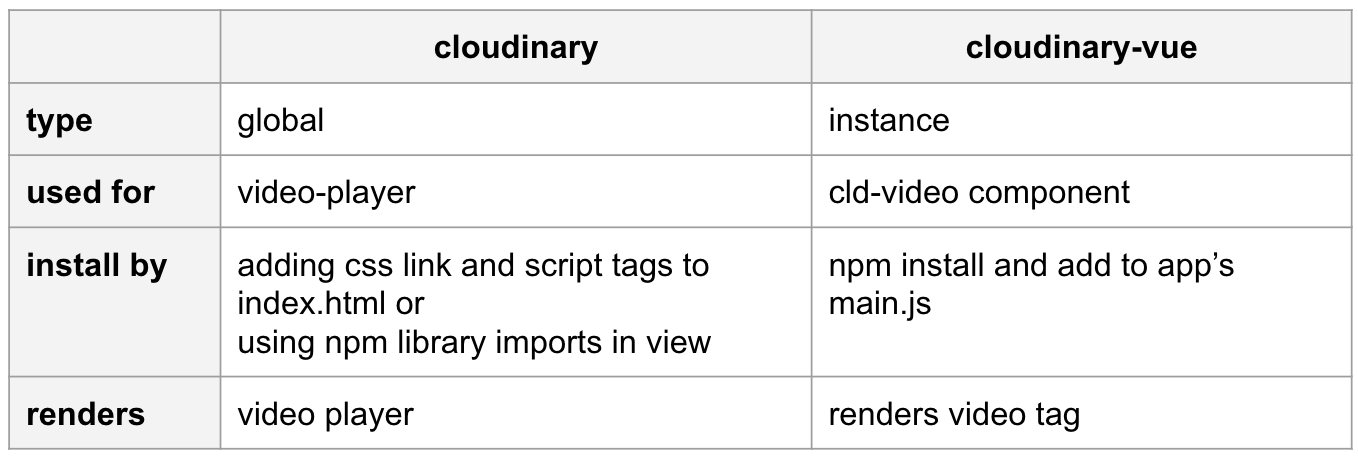Video in Vuejs app
Video in a JavaScript Single Page App
Questions come up in support on how to integrate the Video Player into JavaScript SPA Framework code. We’ll see that it's a matter of determining how to:
- import libraries
- add video tag to template
- add Vue.js Vuejs SDK video tag
- execute
videoPlayerfunction
In this section we'll implement both the video player and the Vuejs SDK in a Vue.js app. This provides a comparison of implementations and results for each of these methods of making video available in a front end framework application.
Exercise: Run a Vue.js app
You’ll need to have the Vue.js CLI installed to run these commands:
npm install -g @vue/cli
Start by uploading a logo image.
node video-player/upload-logo.js
Start the app in development mode.
cd video-player/vuejsnpm installnpm run serve
Open in browser at http://localhost:8080/
You'll see an app with 2 routes: player and tag. These routes run the same video using the Cloudinary Video Player and the Cloudinary generated HTML 5 video tag respectively.


You already have experience running these in a static HTML index.html but now you'll see how to incorporate these in an Vue.js application.
Vue.js SDK vs Cloudinary Video Player
The table below compares the JavaScript objects that render Video Player and Vue.js HTML 5 tag. The biggest difference between these objects is that the Vue.js SDK will render an HTML 5 video tag, while the Video Player will render all the elements needed to construct a video player. It important to note that the video player uses a global object while the vuejs SDK uses a Vue plugin. This can be an issue in single page apps that use a build process that requires typing or linting.

Coding
You can see the dependencies for this app in the package.json.
"dependencies": {"cloudinary-core": "^2.8.2","cloudinary-video-player": "^1.3.4","cloudinary-vue": "^1.0.1","current-script-polyfill": "^1.0.0","lodash": "^4.17.15","vue": "^2.5.22","vue-router": "^3.1.6"},
The Vuejs app requires vue and the vue-router provides routing. The Vue.js SDK only requires cloudinary-vue. The video player requires cloduinary-core, cloudinery-video-player, lodash and current-script-polyfill.
Video Player
Add the following the <script> in the Player view.
import "../node_modules/cloudinary-video-player/dist/cld-video-player.min.css"import cloudinary from 'cloudinary-core';import "../../node_modules/cloudinary-video-player/dist/cld-video-player.min.js";
Add the following to the template portion of the Player view.
<video id="demo-player" width="500" class="cld-video-player" ></video>
Then, add the code that instantiates the JavaScript SDK and wraps the video tag above in Player elements. The code is added to the mounted life-cyle event to so that it will not be executed until the DOM has been mounted and you can manipulate it. If you were working with the react framework you might use the componentDidMount life-cyle hook or with angular, the ngOnInit life-cycle hook to set up the video player code.
Notice that there is an eslint exception because the cld object is global.
mounted: function() {/*global cloudinary*//*eslint no-undef: "error"*/const cld = cloudinary.Cloudinary.new({cloud_name: "<cloud name>"});const demoplayer =cld.videoPlayer("demo-player").width(600);demoplayer.source("<public id>");}
Vuejs SDK
Instantiate Vue and provide the cloud name in main.js .
import Cloudinary from 'cloudinary-vue';Vue.use( Cloudinary, {configuration: {cloudName: "<cloud name>"}});
Install the component in the template portion of the Tag view. You can optionally supply the cloud name in the the cld-video component.
<cld-video cloudName="<cloud name>" publicId="<public id>"></cld-video>